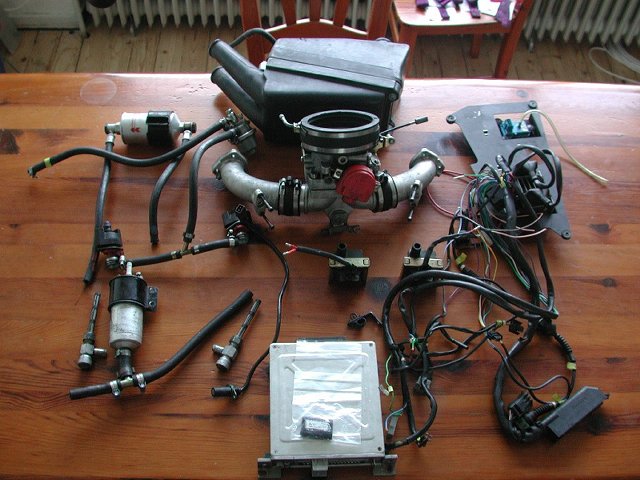VEMS looks to be just the thing I was looking for to go beyond carburettors.
My project
- Guzzi V75/4 motorcycle
- 90 degrees 2 cylinder V-twin, firing interval 270/450 degrees
- that is "gaps of" 3 and 5 (*90 degrees), respectively. So an 8 cylinder setup with only ignchannel2 and ignchannel3 used out of the 8 (the rest mapped to unused ignchannel7):
- h[2]=07 07 07 07 03 07 07 02
- 750 cc, Normally aspirated. carburettors: 2x Dell'Orto 30 mm
- 65 Hp approx, 7000 rpm max.
- I already have a NB O2 sensor in one of the two exhausts (helped in jetting the carburettors. )
I will use the bike for street use only. Basically, I want to learn hands-on about EFI. I am not looking for a performance increase. Lower fuel consumption might be nice, though.
Me and my Guzzi on a cold morning last winter:

Bought lots of second hand EFI bits from a Moto Guzzi Quota to make a start.. :)

- Two intake manifolds with Weber-Marelli IW 042 injectors (16.2 Ohm, 190 cc/min @ 3 bar)
- Throttle body with two 42 mm throttles and TPS
- Fuel pump (Weber PI021), filter, regulator (2.5 Bar)
- Various sensors and the original Marelli P7 ECU which I will not be using.
Plan
- Modify intake manifold to fit engine; fit throttle body, air filter, fit other EFI bits.
- Generate more timing info; either by multi-toothed wheel for the camshaft VRS or add VRS on the crankshaft.
- Buy VEMS!
Eventually
- Have the VEMS do ignition as well as injection. Load-dependent ignition advance will be nice, I only have an RPM-based advance now.
- One, maybe two WB02 sensors?
Trigger
At present I only have this (VRS) trigger for the ignition on the camshaft. There is no cranksensor.

I want to make a new rotor for this with more pulses. At present I am thinking of 12-1 teeth. Since I have two pickup coils (135 degrees apart), I can then do 'static' position detection: Normal operation means the two pickups generate alternate pulses and the missing tooth gives two consecutive pulses from the same sensor.
- Is 12-1 on the camshaft a sensible idea or are there good reasons to make something else?
- you want 16-1 12-1 is not good because there is no good trigger-tooth selection that way (for both cyls). Check the h[2] thoughts above
Good point. However, the pickup has two trigger coils that are 135 degrees apart, so I can do a correct trigger-tooth selection with *any* number of teeth, pickup #1 will do the left cylinder, and pickup #2 will do the right cylinder. This requires VEMS with two VRS inputs, but VEMS hardware supports this. On a related note, I have since found a factory trigger wheel that fits the crankshaft. That would mean no home-made trigger wheel for the camshaft would be necessary. The factory crankshaft trigger wheel is 4+1 teeth (three single and one double tooth). Does VEMS firmware support such a configuration already or will I need to modify the firmware myself?
MAP sensor I have is rated at 100 kpa. 100 kPa should work well in an NA engine. No need for the 250 kpa sensor (but that would work too).
Fuelpump PWM
I am rather short on electrical power. I have a generator that puts out 280W at most, and after 80W for lights and 25W for heated handgrips, that doesn't leave a lot for EFI. I was thinking of doing PWM for the pump to save power. I can see two possibilities.
a) Measure fuel pressure, no return line, and PWM the pump to keep the pressure constant.
b) Keep the pressure regulator and the return line, but PWM the pump (feed-forward, based on injection pulsewidth, RPM and battery voltage, all of which the ECU knows), to keep the return-flow as low as possible to save power.
PWM-ing the fuelpump seems more risk than benefit. Also, you want to have available electric power even at maximum engine power.
175W / 12V = 14.6A
- 2A for injectors
- 1A for ignition
- 0.3A for ECU
- leaves 11.3A for fuelpump. Isn't that enough for an NA bike pump ?
Yes, 11A is enough for the fuel pump. (I measured it at approx 4 A). But full-power is not where the problem is. The problem is extended running at low RPM (city traffic), where generator output is (far) less than the rated 280W. I would also like some current left to charge the battery. Fuel pump PWM would be useful there. I agree that this is probably not something to start with; (enough variables as is), but it is certainly possible and useful, so I want to keep this option open for the future. I see no real reason not to. A spare injector FET should drive the fuel pump without a relay with no problem.
Apparently, there are some Ford Focus engines running with a PWM'ed fuel pump (and no fuel return line?). If Ford can do it, so can I... :)
Thanks for your input!